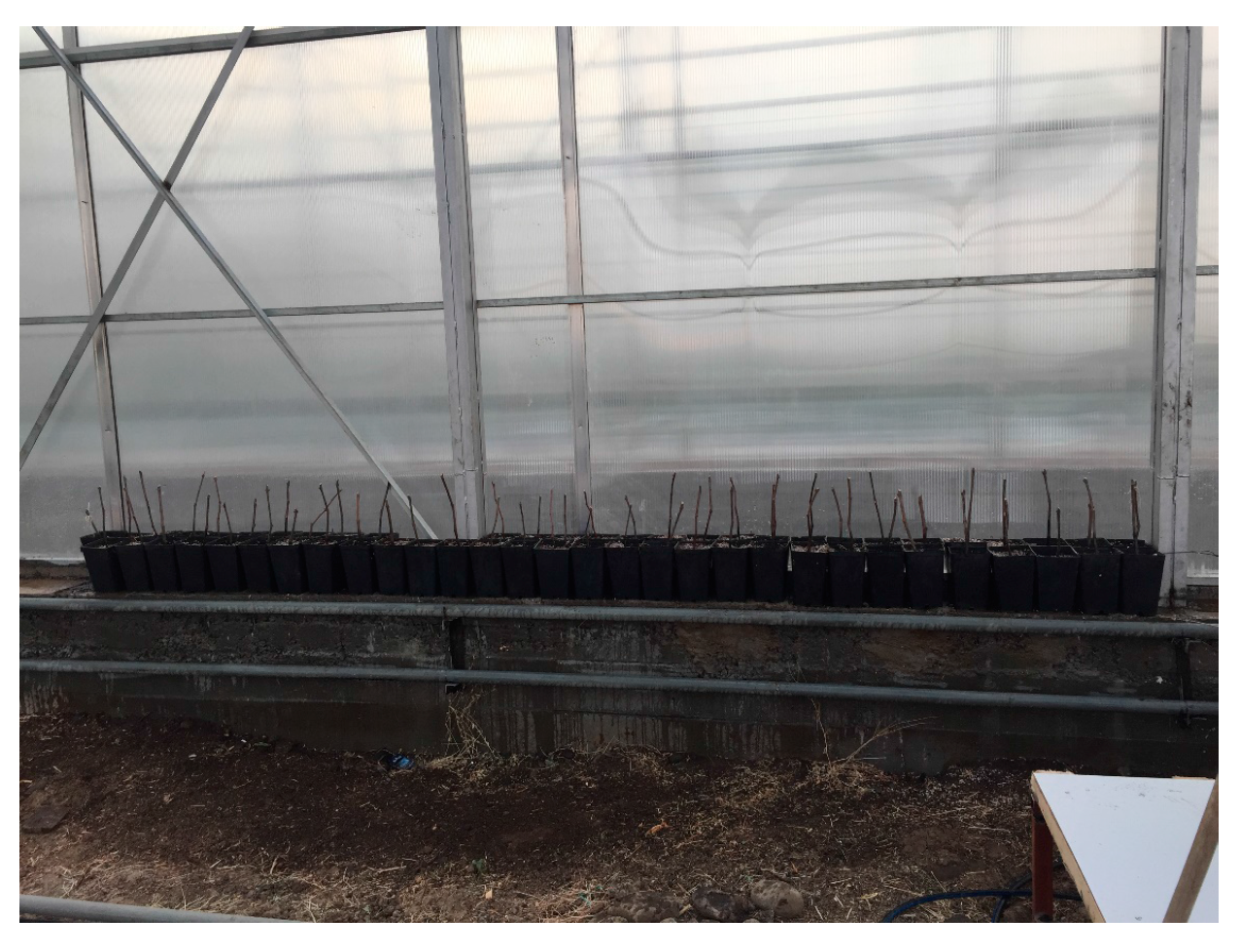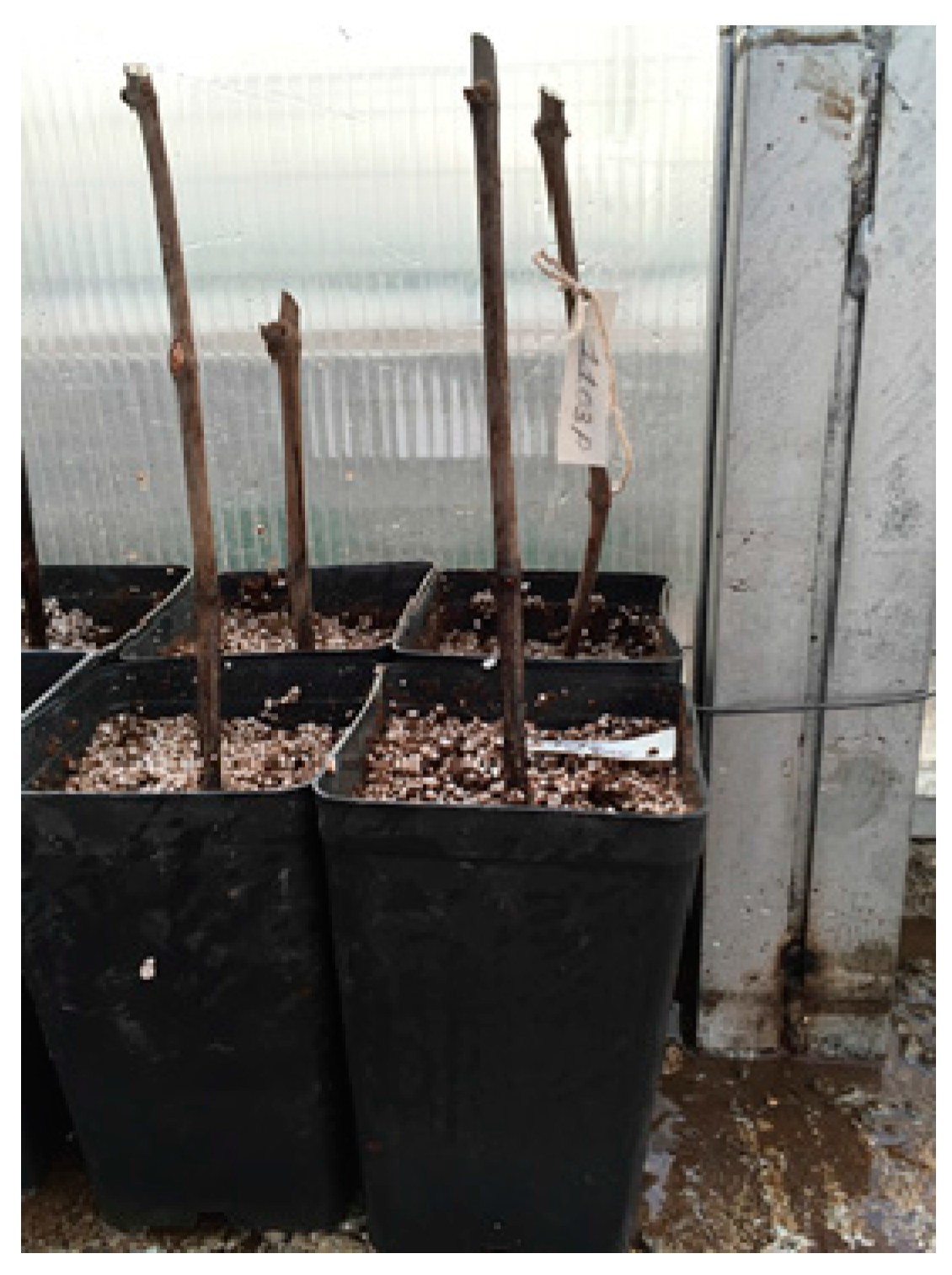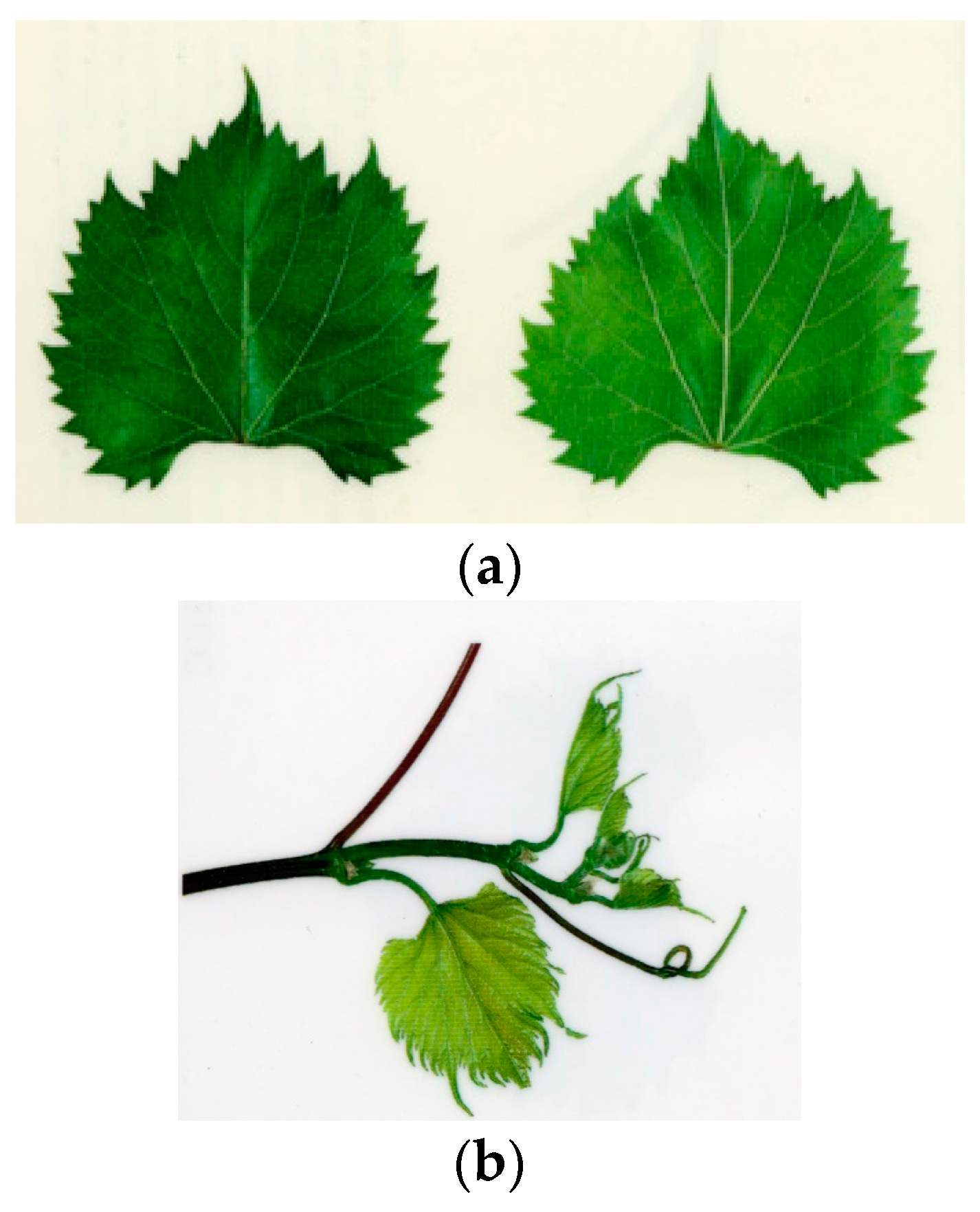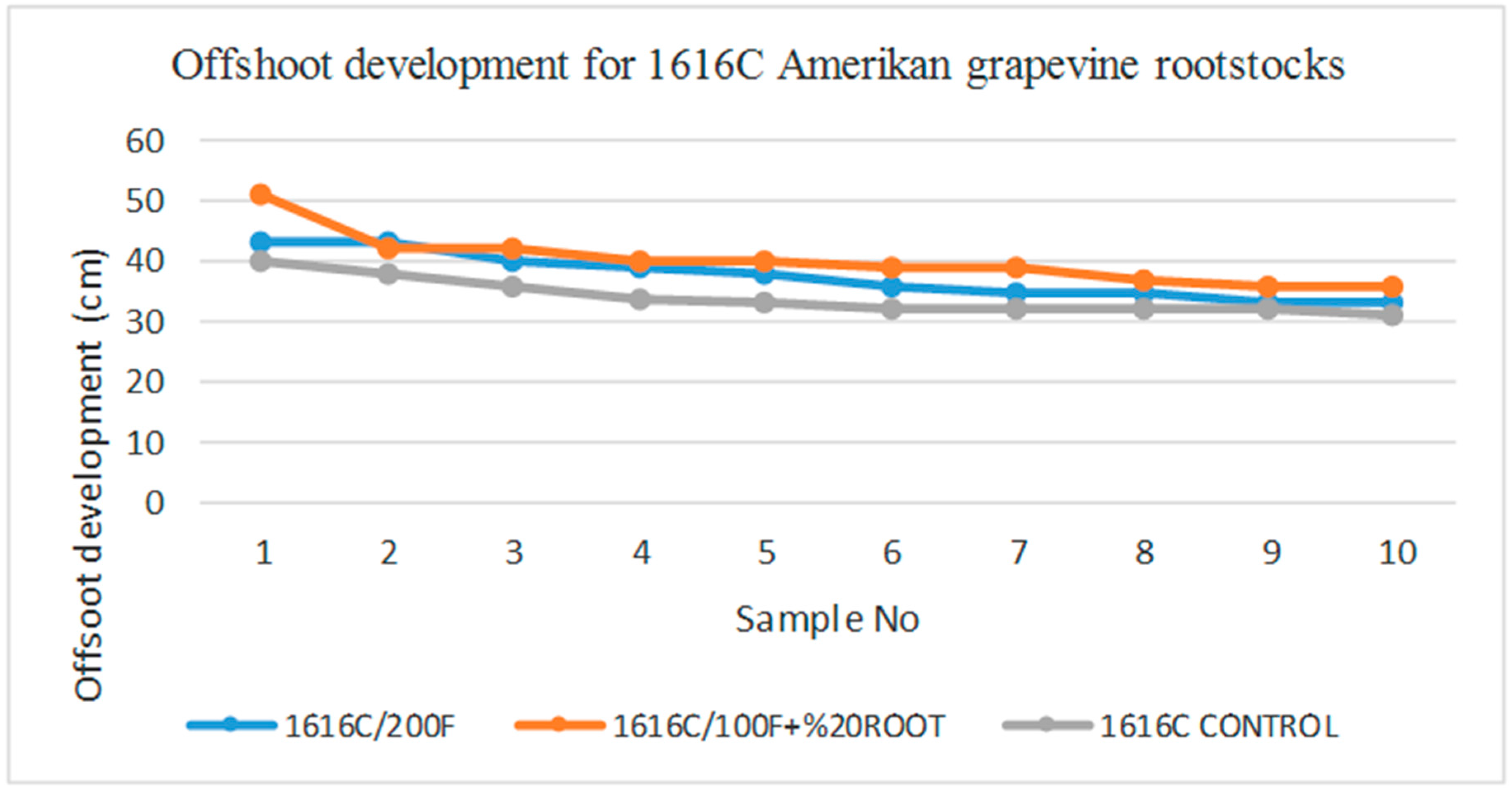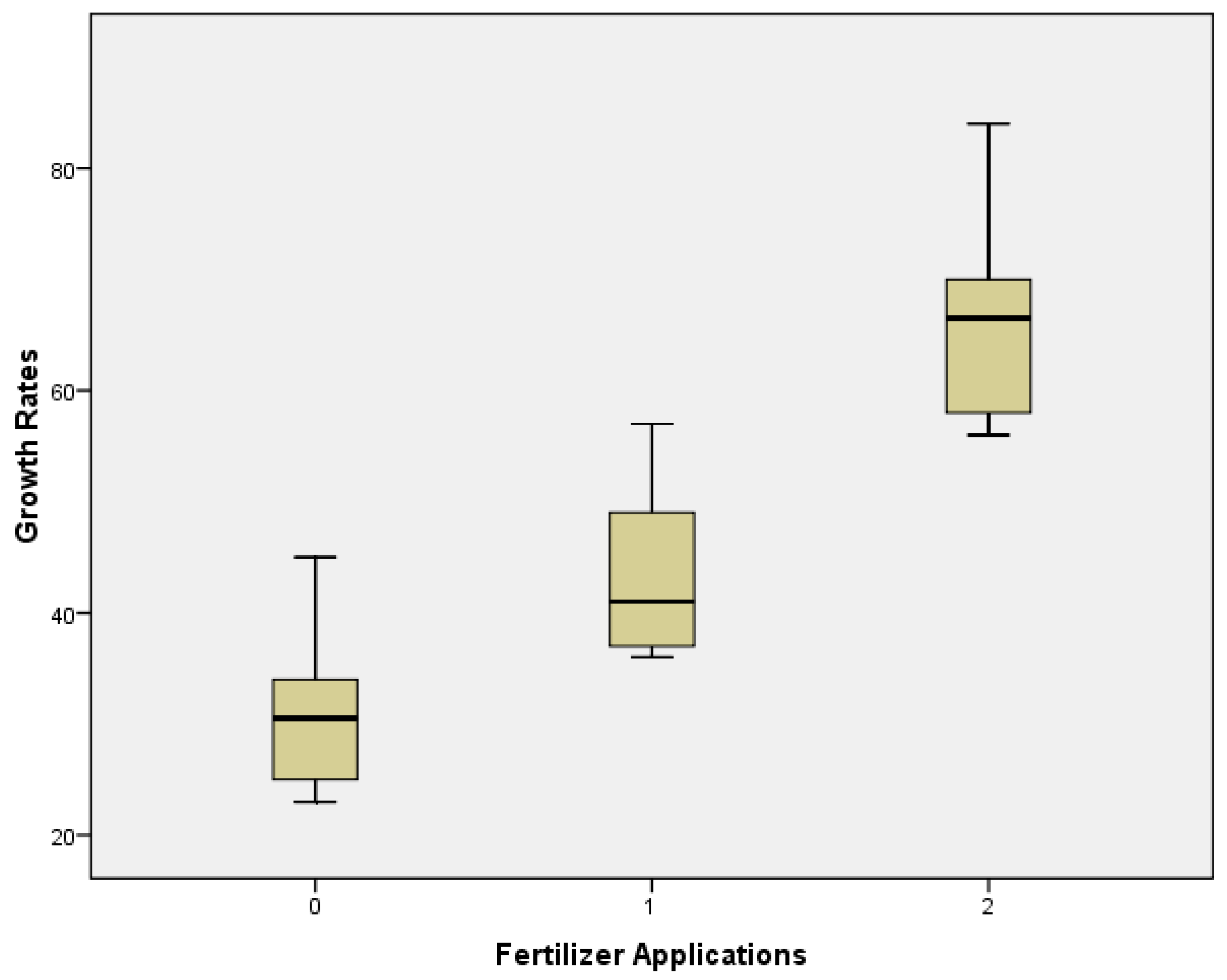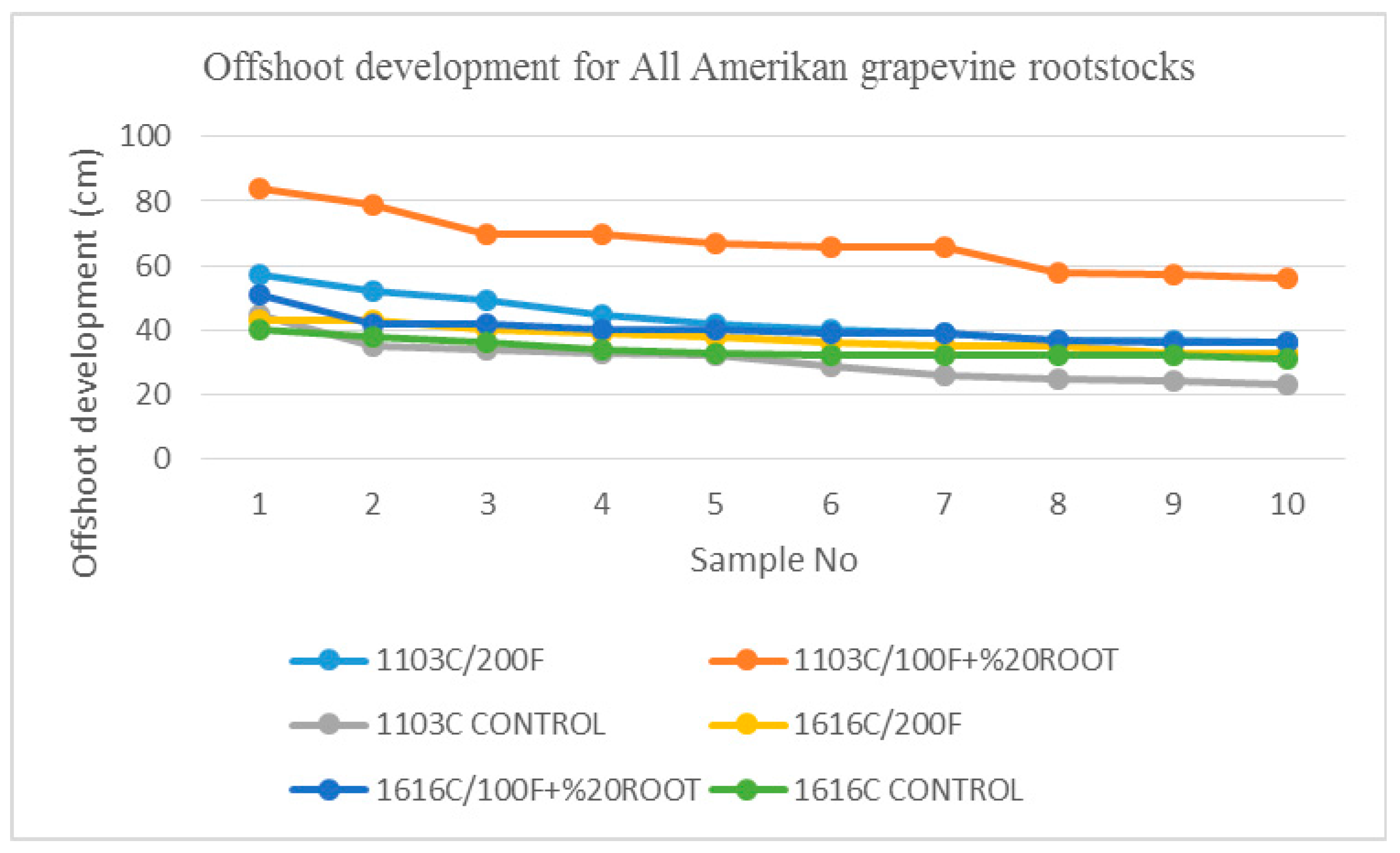1. Introduction
Grapevine, which is a significant branch of agricultural sector and a valuable plant species having accompanied humankind’s journey of knowing oneself, has reached its present status by being improved in accordance with human needs with its historical importance and sacred values ascribed by many religions.
Turkey has been the cradle and center of viticulture throughout history especially because of its climatic and soil characteristics [
1].
Grapevine, which already had importance because of its diversity, productivity and its support to economy for centuries, has been more popular recently especially owing to resveratrol that plays an important role to protect human body from cancer and makes it stronger against viruses and regulates gastroenteric system [
2]. Apart from these, it is also possible to see grapevine figures on historical fountains and gravestones in different civilizations in the history. Finally, the idea that grapevine can be used as a vertical garden plant is partly because of the fact it was ornamentally used on stone walls in history.
Moreover, the opportunity to find nature in cities where green-fields decrease more and more decreases because of structuring, because open spaces are not scattered equally in the city. It is possible to find large and interrelated forests and light green fields in the city edges. However, green fields are almost nonexistent in densely populated areas. Existing green fields are in small fractions scattered throughout all the city, which are the remains of ruined natural vegetation having covered large areas in the past [
3]. At first, roof surfaces and yards were used to vegetate the buildings. However, the fact that front facades cover more space resulted in the vegetation of these areas, providing benefit for both the building and the environment. As a result of all these developments, the concepts of living walls, green facades and wall vegetation were developed with new researches. In a study conducted in Toronto University, a model vertical garden was built and it was determined that the amount of the energy spent for air circulation, energy consumption and cooling decreased. The same study became helpful in reducing the obstacles to the proliferation of vertical gardens such as lack of knowledge, lack of incentive for application, the obstacles based on cost, technical problems related to uncertainty and risks [
4].
Accordingly, it is obvious that, in the past, especially grapevines were used in vertical gardens. Vertical garden is an idea that is as old as the cities and first appeared in Babylon 2500 years ago. King Nebuchadnezzar II had Hanging Gardens of Babylon, which are regarded as the ancestor of green walls by many people today, built. As a matter of fact, Hanging Gardens of Babylon included green roofs in addition to green walls [
5].
The use of grapevine—which took a place in our lives at all points thanks to its various uses, its significance for nutrition and human health, its use in architecture and decoration in the past—in environmental planning [
6] and landscaping led to the opinion that it can have a good effect on human psychology with its pleasant outlook.
Greenwalls have so many effects on environments and those who live in them. Protecting the surfaces from damages, making people mentally more comfortable and making contributions to ecologic characteristics can be accepted as the most mentioned effects. Nowadays, it is also possible to see that some vegetables can grow on greenwalls and this is really important as edible landscapes have been accepted one of the most important components of urban areas [
7].
This study was conducted, in accordance with this opinion, in order to investigate the usability of grapevine as vertical garden and edible landscaping element in continental climate with minimum cost while vertical green surfaces are accepted as one of the best ways to create sustainability in especially urban areas.
2. Material and Method
2.1. Material
This study was conducted in Bingol University, Faculty of Agriculture Research and Application Area in 2016. Taking the climatic conditions of Bingol city into consideration, 1103 P and 1616 C American grapevine rootstocks, which are recommended for many regions in our country with continental climate, were used as vegetative material in the experiment (
Figure 1 and
Figure 2).
The most common parts of the grapevines that were ornamentally used in figures on historical walls are vegetative organs. Apart from this, coverage by plants on the walls is considered the most important issue on greenwalls. Because of these two phenomena, fast growing and well known grapevines were selected as the research material.
2.1.1. Some Characteristics of 1103 P American Grapevine Rootstock
Offshoot point is hairy like spider web and pink. Young leaves are hairless and bronze. Ripe leaves are kidney-shaped and petiolar sinus is U-shaped (
Figure 3). Their internodes are purple, half-hairy, and have female and sterile flower structure. This rootstock which grows strongly can resist active lime in 17–18% ratio. It is resistant against 0.6 g/kg salt. The rate of its taking inoculation and root is very high [
8,
9,
10,
11].
2.1.2. Some Characteristics of 1616 C American Grapevine Rootstock
Offshoot point is hairy like spider web, young leaves are pale green and hairy like spider web. Ripe leaves have 5 corners and leaf sinus is open, lyre-shaped (
Figure 4). It has typical female flower characteristics and cluster small black grains. Yearly bars are pinstriped and internodes are long.
It can grow better in humid soils and its inoculation can accelerate its ripening.
1616 C American grapevine rootstock is pretty durable against phylloxera and its resistance against lime is about 11% [
9].
2.2. Method
2.2.1. Obtaining the Cuttings, Their Protection and Planting
1103 P and 1616 C American grapevine rootstock cuttings used in the experiment were obtained from Manisa Vitivulture Research Station Management. These cuttings were taken from the well-lignified middle parts of one-year-old branches following the defoliation, as Roux reported (1988) [
12] Their lengths were adjusted to 30–40 cm according to TS-4027, the ones with 8–12 mm diameter were fastened in bunches of 50 [
13] and they were preserved in polyethylene plastic bags in cold storages having +4 °C temperature and 95–98% relative humidity [
14].
Pearlite + Peat + garden soil mixture in 1:1:2 proportion was used as the rooting environment. Analysis results belonging to the environment used in rooting was given in
Table 1. Rooting environment having been prepared in the stated proportions was scattered among the vases of 14 × 14 × 20 cm sizes, about 1625 g for each one. The cuttings belonging to the rootstocks which were taken to these rooting vases were planted by blunting the buds and keeping two buds out (on 6 April 2016).
2.2.2. Setting up the Experiment
The study was supported with the applications on 6 different groups. The cuttings were planted in the vases on 11 April 2016 and they started to shoot stocks on 21 April 2016.
As from 21 April 2016 when grapevine buds completely shot stocks, grapevines were taken out of the greenhouse environment to a field with a northern exposure in order for them to adapt to outside conditions. After being kept here for almost a week, it was transferred to the open space where the experiment would be set up.
The cuttings which were irrigated at regular intervals were also subjected to the necessary cultivation processes. To provide homogeneity for the cuttings having shot stocks, the cutting other than the ones which reached a specific height (5–10 cm) were cut by pruning and taken away from the cuttings which shot stocks.
2.2.3. The Application of Fertilization in the Cuttings Used in the Experiment
Fifteen vases were used for each application—one cutting of shooting stock in each vase—in the experiment which was set up according to randomized blocks experimental design.
The experiment was set up as Control, First Application and Second Application and no application was conducted on the control group. Fertilizer solution in 200 g/100 L water concentration was applied through the leaf. Fertilizer solution in 100 g/100 L water concentration was applied through the leaf, and fertilizer solution in 40% g-water concentration was applied on the root (150 cc/cutting) five times every 10 days starting from 21 July 2016.
20 + 20 + 20 + ME was used as a fertilizer because it can be implemented from both roots and leaves, which makes the process faster, and because it has basic macro and micro nutrients. The Fertilizer used in the applications was 20 + 20 + 20 + ME and the plant nutrition elements it contained are given in
Table 2.
3. Research Findings
Grapevine rootstocks taken out of the greenhouse environment were kept waiting until they grew ripe and the applications started on 21 July 2016. These applications were conducted in 5 recurrences at 10 day-intervals. After collecting the data, graphics were separately created for each group.
Height averages of the offshoots in 200 foliar fertilization application (first application) in 1616 C American grapevine rootstock group were measured as 56.2 cm. It was observed that after foliar fertilization was applied on 1616 C American grapevine rootstocks, the offshoots grew between 43 cm and 25 cm and the average offshoot growth was 34.4 cm. Forty percent of the offshoots belonging to this rootstock grew over 35 cm (
Figure 5).
When 20% root and 100 foliar fertilizer was applied to the same rootstocks (second application), it was observed that the average height of offshoots is 60.3 cm. After the fertilization was applied to 1616 C American grapevine rootstock, it was observed that offshoots grew between 51 cm and 32 cm and average growth was 37.9 cm 66.6%. 1616 C American grapevine rootstocks showed a growth of over 35 cm.
When the control groups in the same rootstocks were observed, it was determined that the average growth in the offshoots is 59.9 cm. Control group offshoots grew between 40 cm and 26 cm and the average growth was 32.1 cm. The 13.3% of the offshoots belonging to 1616 C American grapevine rootstocks in the control group grew by more than 35 cm.
The height averages of the offshoots that grew in 200 foliar fertilization application (first application) in 1103 P American grapevine rootstock group were 80.5 cm. It was observed that after foliar fertilization was applied on 1103 P American grapevine rootstocks, the offshoots grew between 84.0 cm and 46.0 cm and the average offshoot growth was 61.4 cm. The entire offshoot belonging to this rootstock grew by over 35 cm.
When 20% root and 100 g/100 L water foliar fertilizer was applied to the same rootstocks (second application), it was observed that the average height of the offshoots is 56.3 cm. After the fertilization was applied to 1103 P American grapevine rootstock, it was observed that the offshoots grew between 57 cm and 27 cm and average growth was 39.5 cm. Eighty percent of 1103 P C American grapevine rootstocks showed a growth of over 35 cm.
When the control groups in 1103 P American grapevine rootstocks were taken into consideration, it was determined that the average growth in offshoots was 50.5 cm. The offshoots in the control group grew between 45.0 cm and 23.0 cm, and 30.6 cm on average. Only 6.6% of the offshoots of 1103 P American grapevine rootstocks in the control group grew by over 35 cm (
Figure 6).
4. Discussion and Result
Green vertical surfaces improve air quality, decrease heat island effect, make a contribution to heat and sound isolation, save energy, help wildlife and give esthetic value, especially in urban areas and one of the major purposes of this study is to help urban areas to be sustainable and livable by determining the characteristics of the grapevine as greenwall plant.
In this study, the growth of grapevine cuttings and the changes in their coverage areas were examined. It was determined that the rootstocks on which 20% root and 100 g/100 L water leaf fertilizers were applied showed the best development among the experiment groups. Although 1103 P rootstock showed the best development, it was observed from the footprints (average 61.4 cm) that both rootstocks covered the same space (
Figure 7). It was also observed that 1616 C rootstock closed the footprint gap at the end of the application, since it showed a better development in the period until fertilization.
To be able to put the values in the database properly, the rootstocks that have no fertilizer applications were marked as 0, those which have only foliar fertilizer applications were marked as 1 and finally those which have both root and foliar fertilizer applications were marked as 2.
When focusing on 1103 p rootstocks, according to the F test that has 95% Confidence Interval for Mean, the hypothesis can be taken as acceptable with
p = 0.000 < 0.050. This means there are significant differences between the groups that have different fertilizer applications (
Table 3,
Table 4 and
Table 5,
Figure 8).
When focusing on 1616 C rootstocks, according to the F test that has 95% Confidence Interval for Mean, the hypothesis can be seen as acceptable with
p = 0.004 < 0.050. However, there is no significant difference in the second group (among the fertilized groups), which has 1616 C rootstocks and is fertilized at a rate of different doses (
Table 6,
Table 7 and
Table 8).
When evaluating the statistical analyzes, for Bingol where the experiment was conducted, it is more convenient to use 1616 C rootstock when the use of fertilizer is not desired, while it is more convenient to use 1103 P rootstock if fertilizer is to be used, since more space will be covered in this way (
Figure 9).
According to [
7], the most common reasons that make people avoid vertical gardens are:
- -
Installation cost,
- -
Extra weight on buildings and walls,
- -
Damage on buildings and walls by roots,
- -
Maintenance cost.
However, it is clear that vertical gardens might remove the weight of heat and sound isolators from the buildings and walls as they are already heat and sound isolators. Plus, it is obvious that damage on walls is nearly impossible when a natural climbing plant like a grapevine is used on greenwalls as they take water and nutrients from the soil while they only require pruning.
As for the cost analysis of vertical green surfaces, it was calculated for the studies done so far that the cost was 40–75 €/m
2, for the walls supported by wires and knitted wire systems, the cost was about 800 €/m
2, and for the walls on the surfaces of which boxes were used for the habitat, the cost is 1200 €/m
2 for living wall systems [
15]. This explains another important advantage of using grapevines on greenwalls: maintenance cost is supposed to be low compared with typical high-tech greenwalls because it is possible to give nutrients to grapevines with just irrigation. The cost, along with one-year fertilizer maintenance, was calculated to between 30–40 €/m
2 for this system (
Figure 10) built with American Grapevine Rootstocks (
Table 9).
In spite of the fact that vertical green surfaces have been determined to be extremely important by many scientists, urban planners, landscape architects and several other professionals; it is clear that these vertical habitats are not as common as they should be in many parts of the world. As many people living especially in developing countries often want to see some basic benefits in the short term as soon as they make an investment, these green magical surfaces might sometimes seem to be far removed from their pragmatic perspectives, which could be described as a tough challenge. However, there is no doubt that using edible plants such as grapevines for vertical gardens can create a great support for such people, especially among these countries, which naturally makes a great contribution to sustainable and more livable cities.
